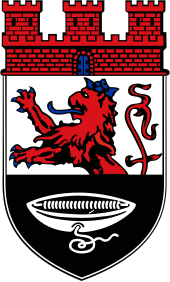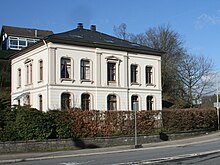Hückeswagen cloth weaving industry
The Hückeswagen cloth weaving industry was the city's most important branch of industry in the 18th and 19th centuries . External evidence of this is the coat of arms of Hückeswagen , which has a silver shuttle on a black background in the lower part of the coat of arms shield . The black color in the lower field is reminiscent of the black cloth that was supplied to the European royal courts and brought the Hückeswagen cloth industry world fame.
For the most part, the water power of the Wupper , the Bever and various streams was used. There were also spinning mills near the castle , in the houses on Marktstrasse . A rope hoist can still be seen on one house, with the help of which the bales of cloth were pulled to the upper floors of the house, where the spinning machines were located.
The cloth weavers who had become prosperous built their residential villas primarily on Bachstrasse - in Hückeswagen they are called cloth makers ' villas . The era ended in the 1970s with the shutdown of the Hueck & Cie company on the Aue after a fire in 1969 destroyed a large part of the company. In 1985, on the occasion of the city's 900th anniversary, a memorial was erected to the cloth weavers on Iceland Street .
Well-known cloth factories in Hückeswagen included:
- Johanny-Abhoe an der Wupper cloth factory (1484 to 1906). The factory was located in Hammern in the Wipperfürth area. In 1484 the factory is mentioned as iron hammer, after 1840 it was converted into a cloth factory by Johanny.
- Cloth factory from HW Kipper, R. Schnabel & Edelhagen an der Wupper (1723 to 1939)
- Ernst Troost's dye works on the Wupper (1810 to 1972)
- Erich Waldthausen's cloth factory on the Wupper (1607 to 1970)
- Dyeing and carded yarn factory v. F. Bockhacker on the Wupper (1823 to 1885)
- Cloth factory of the Schnabel brothers on the Wupper (1164 to 1981)
- Cloth factory owned by WF Löbbecke on the Wupper (1513 to 1963), also known as fulling mill
- C. & F. Schnabel's cloth factory on the Wupper (1831 to 1970), the partner Franz Schnabel built the Villa Schnabel on Bachstrasse between 1860 and 1866
- Carded yarn factory of D. Engels an der Wupper (1840 to 1967)
- 9 iron hammers in Kräwinklerbrücke on the Wupper
- Clarenbach's and Flender's hammer or anvil forge on Heiderstegbach (early 18th century until 1951, see Kräwinklerbrücke)
- Stooter mill in Bevertal (1828 to 1936)
- Platzhausen im Bevertal (1782 to 1898)
- Fröhlenhausen im Bevertal (1753 to 1895)
- Rasselstein im Bevertal (1725 to 1938)
- JD Clarenbach & Sohn's spinning mill in Bevertal (1750 to 1936)
- JD Clarenbach's cloth factory in Bevertal (1719 to 1970)
- The fulling mill at Weierbach (1484 to 1902)
- Farbhaus and Fulling Mill on Brunsbach (1484 to 1970)
- The Fomm'sche Fulling Mill on Brunsbach (1651 to 1910)
- Friedrich Müller's dye works at Brunsbach (1806 to 1960)
- Carl Bockhacker's successor's cloth factory in Dörpetal (1690 to 1956)
- Spinning mill of FW Clarenbach in Dörpetal (1823 to 1969)
- Felbecker Hammer (1734 to 1970)
literature
- 900 years of Hückeswagen 1085 until 1985


